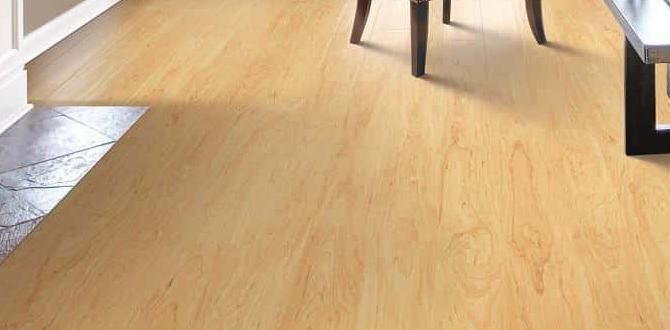Quick Summary:
Choosing the right air compressor involves matching its power (CFM and PSI) to your tools and intended projects. For DIYers and woodworkers, consider horsepower, tank size, and portability. This guide simplifies the process, ensuring you get the perfect compressor for your needs without any guesswork.
Hey there, fellow builders and DIY enthusiasts! Jack Shaffer here from Nailerguy. Ever feel a bit lost when staring at a wall of humming air compressors, wondering which one will actually power your nail gun or carefully tuck away that trim without a fuss? You’re not alone! Picking the right air compressor can feel like a riddle, especially when your projects demand specific power or you plan to grow your tool collection. But don’t worry, we’re going to untangle this together. By the end of this guide, you’ll have the confidence to select an air compressor that’s a perfect fit for your workshop and your wallet.
This guide will walk you through everything you need to know, from understanding key specs to making the final decision. Let’s get started and find you that perfect compressor!
Table of Contents
Why the Right Air Compressor Matters for Your Projects
An air compressor is the heart of any pneumatic tool setup. Think of it as the powerhouse that delivers the compressed air needed for everything from driving nails into tough hardwoods to inflating tires or running sanders. Using an underpowered compressor can lead to tools underperforming – imagine a nail not fully sinking into wood, or a spray gun sputtering. On the flip side, an oversized compressor might be overkill, costing more to buy and run than you need. Getting it right from the start means your tools will work efficiently, making your projects smoother, faster, and much more enjoyable. It’s about having reliable power exactly when and where you need it.
Understanding the Key Specs: What to Look For
When you’re looking at air compressors, you’ll see a few terms pop up again and again. Let’s break down the most important ones so you know exactly what they mean for your tools.
1. Horsepower (HP)
Horsepower tells you roughly how much power the compressor’s motor has. Higher HP generally means the compressor can do more work. However, HP isn’t the be-all and end-all. What’s often more important are the other specs, like how much air it can deliver.
2. Cubic Feet per Minute (CFM)
This is arguably the MOST important number. CFM measures how much air the compressor can deliver per minute at a specific pressure. Your tools have a CFM requirement listed on them or in their manuals. You need a compressor that can meet or exceed this requirement, especially if you plan to run multiple tools or a tool that uses a lot of air (like a sander or framing nailer).
Why it’s crucial: If the CFM is too low, your tool might struggle to keep up. For a nail gun, this means it might not sink nails consistently. For something like a sander, it could lose power quickly.
3. Pounds per Square Inch (PSI)
PSI measures the air pressure the compressor can generate. Most air tools operate effectively within a range of 40 to 90 PSI. Your compressor needs to be able to reach the required PSI for your tools, but most compressors easily exceed the typical needs of common DIY tools. The key is that the compressor delivers the volume of air (CFM) at the necessary pressure (PSI).
4. Tank Size (Gallons)
The tank is a reservoir for compressed air. A larger tank means the compressor has more air stored up, so the motor doesn’t have to run as often. This is especially helpful if you have a job that requires a constant supply of air or if you’re using tools that are air-hungry.
- Smaller tanks (1 to 6 gallons): Good for portability, air brushing, or light-duty tasks like inflating tires or powering a brad nailer for short bursts.
- Medium tanks (10 to 30 gallons): A sweet spot for many DIYers, offering a good balance of air supply and portability for tasks like trim nailing, stapling, or running impact wrenches periodically.
- Larger tanks (50 gallons and up): Best for continuous use, running multiple tools, or powering demanding tools like framing nailers, sanders, or paint sprayers for extended periods.
5. Horsepower vs. Air Delivery
Don’t get too hung up on HP alone. A 1.5 HP compressor with excellent air delivery (CFM) can outperform a 3 HP compressor that struggles to keep up. Always prioritize CFM at a given PSI. Manufacturers often list both, but look for the CFM rating at 90 PSI, as this is a common benchmark for tool operation. For example, a brad nailer might need 0.3 CFM at 90 PSI, while a framing nailer could need 2.3 CFM at 90 PSI. You need enough CFM to handle your most demanding tool.
Types of Air Compressors: Which is Right for You?
Air compressors come in different styles, each suited for specific needs. Understanding these types will help you narrow down your choices.
1. Portable Compressors
These are designed with mobility in mind. They are typically smaller, lighter, and often have wheels and handles. They are perfect for taking to different job sites, around the yard, or for storage in a tight space.
- Pancake/Hot Dog style: Usually have smaller tanks (1-6 gallons) and are very compact. Great for small tasks and portability.
- Twin-stack: Feature two smaller tanks, offering a bit more capacity and air delivery than a single pancake style, while still being relatively portable.
- Wheelbarrow style: Larger, with bigger tanks (20+ gallons) and wheels, making them easier to move around a workshop or job site despite their size.
2. Stationary Compressors
These are the big boys! Stationary compressors are designed to stay put, usually mounted on a base and often bolted down. They offer the largest tank sizes, highest CFM ratings, and most power, making them ideal for dedicated workshops where high demand is constant.
- Tank sizes: 50 gallons, 60 gallons, 80 gallons, and much larger.
- Power: Can be powered by electric motors or gas engines. Electric ones are common for home workshops, while gas is for out in the field.
- Noise: Tend to be louder, so they are often housed in separate rooms or sheds for noise reduction.
3. Oil-Lubricated vs. Oil-Free Compressors
This is a crucial distinction for maintenance and air quality.
Oil-Lubricated Compressors
- Pros: Generally more durable, designed for heavy-duty use, and can run longer without overheating. They are often quieter than oil-free models of similar power.
- Cons: Require regular maintenance – checking and topping up oil levels, and periodic oil changes. The compressed air can contain tiny amounts of oil, which might be an issue for painting or sensitive applications.
Oil-Free Compressors
- Pros: Low maintenance – no oil to check or change. The air produced is cleaner, which is better for painting, medical applications, or food-related uses (though not typically for home DIY). They are generally lighter and more portable.
- Cons: Can be louder and may not be designed for the same continuous duty cycle as oil-lubricated models. They might have a shorter lifespan under heavy use.
For most DIY woodworking and general tasks, an oil-lubricated compressor will offer better longevity and performance if you plan on frequent or demanding use. For occasional light tasks or when portability is key, an oil-free might suffice.
Matching Your Compressor to Your Tools and Tasks
The real trick to choosing an air compressor is to match its capabilities (mainly CFM) to the requirements of your tools. Think about the primary tools you’ll be using and their air needs.
Common Tools and Their Air Needs (Approximate)
Here’s a handy table to give you an idea. Remember to always check your specific tool’s manual for exact requirements!
| Tool | Typical CFM Requirement (at 90 PSI) | Tank Size Recommendation | Notes |
|---|---|---|---|
| Brad Nailer | 0.3 – 0.6 CFM | 1-6 Gallons | Very low air demand. Most compressors can handle these easily. |
| Pin Nailer | 0.3 CFM | 1-6 Gallons | Similar to brad nailers, great for delicate work. |
| Stapler | 0.6 – 1.0 CFM | 2-10 Gallons | Slightly more demanding than nailers. |
| Finish Nailer | 1.0 – 1.5 CFM | 6-20 Gallons | Good for trim work. Needs a bit more airflow than brad nailers. |
| Framing Nailer | 2.0 – 3.0 CFM | 20-60 Gallons | High air demand for driving large nails into structural lumber. Needs a robust compressor. |
| Impact Wrench (1/2″) | 4.0 – 6.0 CFM | 30-80 Gallons | Air-hungry; requires a powerful compressor and steady air supply. |
| Orbital Sander | 8.0 – 12.0+ CFM | 60+ Gallons (Recommended) | Very high and consistent air demand. Needs a large, powerful compressor. Continuous duty rated is important here. |
| Paint Sprayer (HVLP) | 5.0 – 14.0+ CFM | 30-80 Gallons (Recommended) | Depends heavily on type and size. Some require specialized setups. Always check the sprayer’s needs. |
Key Takeaway: To choose how to choose air compressor for multiple nail guns, you need to look at the highest CFM requirement among the nail guns you plan to use simultaneously and add a little buffer. If you have a framing nailer (3 CFM) and a finish nailer (1.5 CFM), and might use them at the same time (unlikely for most DIYers, but possible for pros), you’d ideally want a compressor that can deliver at least 4.5 CFM, and probably more to account for losses and ensure longevity.
Factors to Consider Beyond Specs
While CFM, PSI, and tank size are king, a few other things can influence your decision.
1. Power Source: Electric vs. Gas
Electric Compressors:
- Pros: Quieter, produce no fumes, and are generally easier to maintain for home use. They are ideal for indoor workshops or garages. Available in 120V (standard outlet) and 240V (requires a dedicated circuit, more power).
- Cons: Need to be near an electrical outlet. Cord length can be a limitation for portability unless you use an extension cord (though heavy-duty ones are recommended). 120V models have limitations on power compared to 240V or gas.
Gas-Powered Compressors:
- Pros: Highly portable as they don’t need electricity. Offer robust power and high CFM ratings, making them suitable for remote job sites.
- Cons: Much louder, produce exhaust fumes (require outdoor or very well-ventilated use), and demand more maintenance (fuel, oil changes for the engine).
For most home workshop DIYers, electric is the way to go. If you’re frequently working in locations without power, gas is your only option.
2. Portability and Size
How will you be using your compressor?
- Workshop permanently set up? A larger stationary unit might be best.
- Moving between rooms or outdoor projects? Look for a portable unit with wheels and a manageable weight.
- Small apartment or limited space? A compact pancake or hot dog style is your friend.
A compressor that’s too heavy or cumbersome to move where you need it will quickly become a frustration. Always lift with your legs!
3. Duty Cycle
This is crucial for heavy-duty applications. The duty cycle of a compressor tells you how long it can run within a given period before needing to cool down. It’s usually expressed as a percentage. For example, a 75% duty cycle means the compressor can run for 9 minutes out of every 12 minutes. For basic nailing, this isn’t usually an issue. But for continuous tasks like sanding or extensive spraying, you’ll want a compressor with at least a 75% or, ideally, a 100% duty cycle (continuous duty).
Most compressors designed for DIY use have an oil-lubricated pump, which typically boasts a better duty cycle than oil-free units.
4. Noise Level
Compressors can be LOUD! This is especially important if you work in a shared space, have close neighbors, or simply want to avoid ear fatigue. Noise is measured in decibels (dB).
- Typical compressors: 70-90 dB
- Quiet compressors: below 70 dB
If noise is a concern, look for models specifically marketed as “quiet” or “low noise.” You might also consider building an insulated enclosure or placing the compressor in a separate shed or basement if possible. Check out resources like OSHA’s guidelines on noise safety to understand hearing protection levels.
5. Build Quality and Brand Reputation
Investing in a quality brand can save you headaches and money in the long run. Look for brands known for durability and good customer support. Read reviews from other users to get a sense of real-world performance and reliability. Consider warranties, as a longer warranty often indicates the manufacturer’s confidence in their product.
Step-by-Step: How to Choose Your Air Compressor
Ready to make a decision? Follow these steps:
- Identify Your Primary Tools: Make a list of all the air tools you currently own and all the air tools you plan to buy in the near future.
- Check Tool CFM Requirements: For each tool on your list, find its CFM rating at 90 PSI. This is usually in the owner’s manual or on the tool itself.
- Determine Your Highest CFM Need: Find the tool with the highest CFM requirement. This is the minimum CFM your compressor needs to deliver.
- Add a Buffer: It’s always wise to get a compressor that can deliver about 20-50% more CFM than your highest-demand tool. This accounts for:
- Running multiple tools (though less common for DIYers).
- Air leaks in hoses or fittings.
- Compressor wear over time.
- Ensuring the compressor doesn’t have to work at its absolute limit constantly.
For example, if your framing nailer needs 3 CFM, aim for a compressor delivering at least 3.6 CFM (3 1.2) and ideally 4.5 CFM (3 1.5) or more.
- Consider Your Projects and Usage:
- Occasional light tasks (inflating, brad nailing): A small, portable 1-6 gallon compressor might be perfect.
- Trim work, finish carpentry, air stapling: A 10-30 gallon compressor will likely be a good fit.
- Framing, heavy carpentry, automotive, or continuous use: You’ll need a larger tank (30 gallons+) and higher CFM, possibly a 240V electric or even a stationary unit.
- Sanding, grinding, extensive spraying: These require very high CFM. Look for 50+ gallon tanks and compressors rated for continuous duty.
- Decide on Portability vs. Stationary: Do you need to easily move it, or will it live in one spot?
- Choose Oil-Lubricated or Oil-Free: For durability and heavy use, oil-lubricated is often better. For minimal maintenance and clean air, oil-free works for lighter tasks.
- Factor in Power Source: Electric (120V or 240V) for most homes, Gas for remote spots.
- Read Reviews and Compare Brands: Look for reputable manufacturers and check user feedback on reliability and performance.
- Check Noise Levels: If noise is a concern, prioritize quieter models or plan for sound dampening.
</





